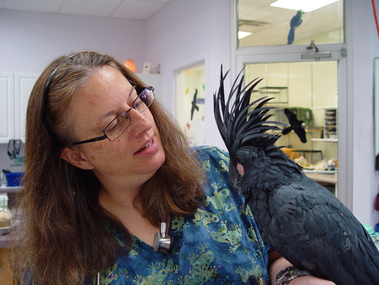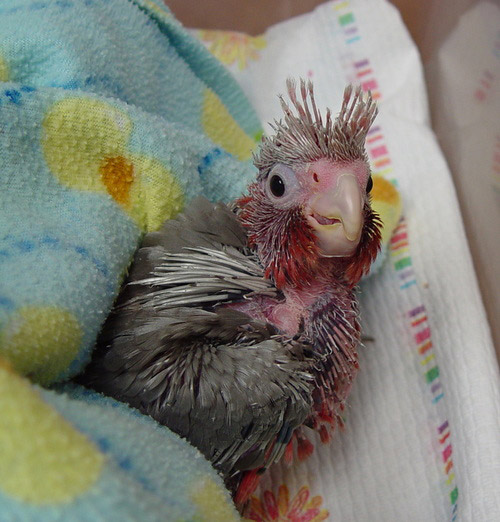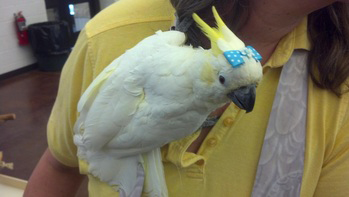Natural History

There are 21 species of these crested birds found throughout Australia, New Zealand, and Indonesia. The name cockatoo is believed to mean vice, so named for their powerful curved beaks. These parrots are one of the most common large birds kept as pets and incidentally one of the most common relinquished to rescue groups. These affectionate birds often become bounded to their owner and misidentify them as mates. Due to their natural monogamy, this can become problematic in homes that aren’t equipped to handle the needs of such an attention demanding bird. With proper care, these birds can become family companions for 30-80 years!
Home Safety
There are many things in the average home that pet cockatoos encounter that can be harmful and even deadly. Some concerns are obvious such as open flames but others such as an air freshener can be easily overlooked.
Potential Household Dangers
- Ceiling fans: birds should never be out when a ceiling fan is on
- Super clean windows and mirrors: birds have a hard time identifying glass and mirrors!
- Electrical wires: dangling wires have the highest potential for issues due to birds desire to hang off or chew these “vines”
- Aerosol sprays: very harmful to the air sacs and lungs
- Candles: the smoke even in small amounts can be very harmful to the air sacs and lungs. Avoid essential and exotic oils used to add scent to candles as well.
- Non-stick cookware: over heated non-stick cookware releases fumes that are both highly toxic to birds and have been linked to MS in humans
- Other pets: this includes other birds, dogs, cats, etc.
- Paint: Paint from the walls of old homes may contain lead.
- Jewelry: Especially costume jewelry can contain zinc.

Diet and Feeding
Cockatoos are herbivores programmed naturally to eat off the ground and some species high in the canopy looking for nuts. In the wild these birds primarily consume seeds, tubers, corm (which is not to be confused with corn), fruit, flowers, and insects as they meander by. Due to their social eating habits, it may be best to feed cockatoos when the household is going to be near them or eating with them in the room. One thing owners have noticed is their tendency when they find something particularly delicious or have come home from an avian rescue is to gorge themselves on food. This is a natural behavior. In the wild, during times of plenty, cockatoos will eat for hours on the best food they can find and store it in their crop for digestion later.
The ideal cockatoo diet consists of:
75% Pelleted Diet
▪ Harrison’s
▪ Zupreme
▪ Roudy Bush
▪ Lafeber
20% Natural Diet
▪ Vegetables
▪ Legumes
▪ Grains
▪ Fruit
5%Treats
▪ Seeds
▪ Nuts
▪ Table Scraps
Remember, all conversions to different diets must be made gradually and care must be taken to monitor food intake as well as weight.
Unsafe Foods:
- Chocolate
- Caffeine (soda, tea, coffee, etc)
- Avocado
- Shelled peanuts (these can contain aflatoxins on the shell)
- Potato skins (these can contain solanine)
Enclosure
With cockatoos, the bigger the enclosure the better! These birds are very active in the wild and need to have ways to relieve their natural energy in the home. Outdoor aviaries are strongly encouraged for their immense energy! However, this isn’t always possible in the home setting and an enclosure of at least 24 inches (2 feet) deep, 48 inches (4 feet) wide, and 48 inches (4 feet) tall are strongly recommended at the very least. Bars should be spaced 1 to 1.5 inches apart depending on the size of the species (excluding cockatiels which really aren’t covered in this care sheet). California King Cages are very popular among Moluccan and Umbrella cockatoo owners. It is incredibly important to make sure that the cage is not constructed of any form of zinc, lead, or galvanized metal as this can cause life threatening toxicity!
Perches should be placed at various heights throughout the enclosure with the softer perch being the highest as this is where most parrots prefer to sleep. Toys should consist of soft wood tree branches, rope toys, cardboard toys, wooden toys, and leather (vegetable tanned only!). Anything that can be picked up with their feet are immediately appreciated as cockatoos love to manipulate and use items!
Lighting
These birds, unlike most parrots, are not early risers! They will sleep in until the sun is up unlike other parrots who will wake up at dawn or just before. Due to this unique behavior, it is important that cockatoo rooms are well lit and offered natural sunlight as well. However, never place a bird cage directly in front of a window. During the day the sun through the window can easily over heat a parrot. Ideally, the light cycle should be 12 hours of light and 12 hours of darkness. In reproductive females, this time may have to be decreased to 8-10 hours of daylight depending on the severity of the hormonal issues. Consult your veterinarian or behaviorist before making changes to the light cycle.

Behavior
These birds are very vocal! Being able to identify their vocalizations can help an owner understand what their bird is trying to communicate:
- Normal: Loud and harsh sounding
- Eating: Soft growls
- Threatening: Hiss
- Morning and Early Evening: Loud short lived squawking for 1-5 minutes (calling to the flock). This is a sign of high spirits but it will get LOUD !
- Screaming: This is not a normal behavior. In the wild, this behavior occurs during fear. Many behaviorists have found that this occurs often when there is no one home for long hours of the day. A day at work with no one home is too long for a cockatoo to be alone! They are very heavy into their flock mentality and will view household members as their flock. However, if this behavior goes uncorrected it can become a stereotypical behavior and will be difficult to remove.
Cockatoos tend to communicate not only vocally but also with their crest. It is important to note the surroundings before an attempt to interpret body language.
- Raised Crest: Displaying for a mate, defending a territory, calling to the flock, curiosity, excitement, fear, frustration, or a warning that a bite will follow soon!
- Lowered Crest: Calmness, friendliness, or approachable
Most owners will purchase these birds as young birds under a year or two old. At this stage they are incredibly affectionate and loving. As these birds start to reach maturity (past 5 years old) their behavior tends to change and during this teenage stage is when most cockatoos are relinquished to rescue organizations. Moluccan and Umbrella cockatoos are the most represented in this scenario! These very sensitive birds go through a time in their life where they act out and can sometimes become aggressive towards owners. This is not necessarily a permanent issue!
In the wild, these birds are raised in the nest and stick close to the flock and their parents during their adolescence, very similar to humans. When these parrots begin to mature and sexual hormones start to surge, these birds will go from the loving overly affectionate birds to trying to drive away their parents. This is normal behavior and to be expected. It is akin to a teenage human trying to leave the nest. This stage, however, can be very trying for cockatoo owners, and especially first time parrot owners. As the hormones settle down with maturity, the cockatoo may bond with owners strongly again, sometimes bonding to a new person in the household, as their potential mate. Issues may arise occasionally if the owner fosters this mate relationship which can lead to aggression of the bird towards other members of the household. Working with a bird behaviorist at this point may be extremely beneficial and prevent frustration on the end of the owner and the bird.
Destruction is often a large problem with these birds. This is not meant to be a malicious act but is simply in their nature! These super intelligent and curious birds require owners to constantly think on their toes and out of the box to create enrichment and mental stimulation. Providing branches to chomp, ropes to climb, toys to groom/crush/throw/shred, toys that can be picked up with their feet, and mechanical puzzles is just the beginning of their daily enrichment. These birds also seem to respond to music and studies have shown that they can identify a beat and move with it. Yes, cockatoos CAN dance! Dancing with your bird to music can be wonderful bonding but take care that you are not handling a potentially overstimulated bird as this can lead to accidental bites.
Feather picking is another common concern with Umbrellas and Moluccans again being the primary offenders. Rose Breasted cockatoos are another species that frequently mutilate their feathers. There are several beliefs about the cause of this issue including inappropriate intense bonding to owners, phobic behavior, boredom, anxiety, etc. An avian behaviorist and a veterinarian (to correct any potential underlying medical issues) is the best way to help a feather picking cockatoo. To help prevent boredom induced feather destruction, toys meant to simulate preening are highly recommended and often cherished. Feather destruction quickly turns into a stereotypical behavior and can become impossible to extinguish. Consulting an avian behaviorist can make the difference!
Biting, high pitched screaming, and feather destruction are often all signs of a bored and lonely bird but they can also be signs of a medical concern. Any change in a cockatoo’s behavior out of the blue warrants a veterinary exam!
Grooming
Cockatoos, like all parrots, require a certain level of grooming on a rather frequent basis. Grooming can be a rewarding bonding moment. For grooming such as beak and nail trims, these are often best left to veterinary professionals as this can be detrimental to the bird if done incorrectly and is often very stressful on the bird as well.
- Bathing: Cockatoos can be very comical in their bathing habits and other can take their bathing very seriously. In the wild, these birds may hang upside down over water, some may flutter through wet leaves, some may full out bath in a puddle, while others fly in rain storms to rinse themselves clean. With the amount of feather debris and down powder that these birds create, bathing options should be offered daily or every other day at least.
- Pedicure: The nails of these birds can become long and often sharp. To keep proper length and to help flatten out the tips to prevent accidental injury to owners, a pedicure is recommended as needed. Typically, for most birds this becomes a 3-6 month routine. Some may need it more often.
- Beak Trim: Beaks are the hands and thumbs that birds don’t have. Proper maintenance of the beak can become difficult in captivity. Beak trims, especially when there is a malocclusion or deformity, should be completed by a veterinary professional. Typically, birds may not need this done or will need it once a year. Some birds need it more often.
- Preening: Birds have a hard time preening their heads and neck, especially when new feathers are growing in. Normally, in the wild, these birds would have a mate or other flock members to help groom them. In captivity, they require assistance from owners. This is an exceptional bonding experience! Older birds, or injured birds, may have trouble reaching tail feathers or feathers growing in on their backs as well.
- Wing Trims: Wing trims are performed to prevent birds from flying with altitude. This is NOT meant to prevent a bird from flying altogether!
Veterinary Services to Consider
- Annual Exams: Cockatoos should have an annual exam performed to check the health status of your pet as well as establish a relationship with an avian vet that can be used in future emergencies and/or for long term geriatric health care. An annual exam should consist of a fecal analysis and blood work.
- Infectious Disease: Testing for diseases such as Psittacosis (which can be contracted by humans), Avian Borna virus (PDD), and Psittacine Beak and Feather disease (PBFD) are important in new birds being introduced to your home or flock. Young birds may benefit from Polyoma testing as well too. Talk with one of our veterinarians for more information on these viruses!
- Grooming: Grooming is ideally performed by a knowledgeable professional for health and safety reasons.

